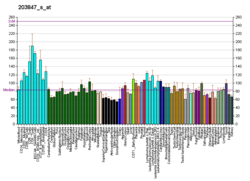AKAP8
Appearance
A-kinase anchor protein 8 is an enzyme that, in humans, is encoded by the AKAP8 gene.[5][6]
Function
[edit]The A-kinase anchor proteins (AKAPs) are a group of structurally diverse proteins, which have the common function of binding to the regulatory subunit of protein kinase A (PKA) and confining it to discrete locations within the cell. This gene encodes a member of the AKAP family. The encoded protein is located in the nucleus during interphase and is redistributed to distinct locations during mitosis. This protein has a cell cycle-dependent interaction with the RII subunit of PKA.[6]
Interactions
[edit]AKAP8 has been demonstrated to interact with:
References
[edit]- ^ a b c GRCh38: Ensembl release 89: ENSG00000105127 – Ensembl, May 2017
- ^ a b c GRCm38: Ensembl release 89: ENSMUSG00000024045 – Ensembl, May 2017
- ^ "Human PubMed Reference:". National Center for Biotechnology Information, U.S. National Library of Medicine.
- ^ "Mouse PubMed Reference:". National Center for Biotechnology Information, U.S. National Library of Medicine.
- ^ a b Eide T, Coghlan V, Orstavik S, Holsve C, Solberg R, Skalhegg BS, Lamb NJ, Langeberg L, Fernandez A, Scott JD, Jahnsen T, Tasken K (Mar 1998). "Molecular cloning, chromosomal localization, and cell cycle-dependent subcellular distribution of the A-kinase anchoring protein, AKAP95". Exp Cell Res. 238 (2): 305–16. doi:10.1006/excr.1997.3855. PMID 9473338.
- ^ a b "Entrez Gene: AKAP8 A kinase (PRKA) anchor protein 8".
- ^ Arsenijevic T, Degraef C, Dumont JE, Roger PP, Pirson I (Mar 2004). "A novel partner for D-type cyclins: protein kinase A-anchoring protein AKAP95". Biochem. J. 378 (Pt 2): 673–9. doi:10.1042/BJ20031765. PMC 1223988. PMID 14641107.
- ^ Akileswaran L, Taraska JW, Sayer JA, Gettemy JM, Coghlan VM (May 2001). "A-kinase-anchoring protein AKAP95 is targeted to the nuclear matrix and associates with p68 RNA helicase". J. Biol. Chem. 276 (20): 17448–54. doi:10.1074/jbc.M101171200. PMID 11279182.
- ^ Eide T, Taskén KA, Carlson C, Williams G, Jahnsen T, Taskén K, Collas P (Jul 2003). "Protein kinase A-anchoring protein AKAP95 interacts with MCM2, a regulator of DNA replication". J. Biol. Chem. 278 (29): 26750–6. doi:10.1074/jbc.M300765200. PMID 12740381.
- ^ Furusawa M, Taira T, Iguchi-Ariga SM, Ariga H (Dec 2002). "AMY-1 interacts with S-AKAP84 and AKAP95 in the cytoplasm and the nucleus, respectively, and inhibits cAMP-dependent protein kinase activity by preventing binding of its catalytic subunit to A-kinase-anchoring protein (AKAP) complex". J. Biol. Chem. 277 (52): 50885–92. doi:10.1074/jbc.M206387200. PMID 12414807.
- ^ Collas P, Le Guellec K, Taskén K (Dec 1999). "The A-kinase-anchoring protein AKAP95 is a multivalent protein with a key role in chromatin condensation at mitosis". J. Cell Biol. 147 (6): 1167–80. doi:10.1083/jcb.147.6.1167. PMC 2168084. PMID 10601332.
Further reading
[edit]- Lester LB, Scott JD (1997). "Anchoring and scaffold proteins for kinases and phosphatases". Recent Prog. Horm. Res. 52: 409–29, discussion 429–30. PMID 9238861.
- Michel JJ, Scott JD (2002). "AKAP mediated signal transduction". Annu. Rev. Pharmacol. Toxicol. 42: 235–57. doi:10.1146/annurev.pharmtox.42.083101.135801. PMID 11807172.
- Collas P, Le Guellec K, Taskén K (2000). "The A-kinase-anchoring protein AKAP95 is a multivalent protein with a key role in chromatin condensation at mitosis". J. Cell Biol. 147 (6): 1167–80. doi:10.1083/jcb.147.6.1167. PMC 2168084. PMID 10601332.
- Steen RL, Cubizolles F, Le Guellec K, Collas P (2000). "A kinase-anchoring protein (AKAP)95 recruits human chromosome-associated protein (hCAP)-D2/Eg7 for chromosome condensation in mitotic extract". J. Cell Biol. 149 (3): 531–6. doi:10.1083/jcb.149.3.531. PMC 2174845. PMID 10791967.
- Akileswaran L, Taraska JW, Sayer JA, et al. (2001). "A-kinase-anchoring protein AKAP95 is targeted to the nuclear matrix and associates with p68 RNA helicase". J. Biol. Chem. 276 (20): 17448–54. doi:10.1074/jbc.M101171200. PMID 11279182.
- Eide T, Carlson C, Taskén KA, et al. (2002). "Distinct but overlapping domains of AKAP95 are implicated in chromosome condensation and condensin targeting". EMBO Rep. 3 (5): 426–32. doi:10.1093/embo-reports/kvf089. PMC 1084102. PMID 11964380.
- Furusawa M, Taira T, Iguchi-Ariga SM, Ariga H (2003). "AMY-1 interacts with S-AKAP84 and AKAP95 in the cytoplasm and the nucleus, respectively, and inhibits cAMP-dependent protein kinase activity by preventing binding of its catalytic subunit to A-kinase-anchoring protein (AKAP) complex". J. Biol. Chem. 277 (52): 50885–92. doi:10.1074/jbc.M206387200. PMID 12414807.
- Strausberg RL, Feingold EA, Grouse LH, et al. (2003). "Generation and initial analysis of more than 15,000 full-length human and mouse cDNA sequences". Proc. Natl. Acad. Sci. U.S.A. 99 (26): 16899–903. Bibcode:2002PNAS...9916899M. doi:10.1073/pnas.242603899. PMC 139241. PMID 12477932.
- Eide T, Taskén KA, Carlson C, et al. (2003). "Protein kinase A-anchoring protein AKAP95 interacts with MCM2, a regulator of DNA replication". J. Biol. Chem. 278 (29): 26750–6. doi:10.1074/jbc.M300765200. PMID 12740381.
- Arsenijevic T, Degraef C, Dumont JE, et al. (2004). "A novel partner for D-type cyclins: protein kinase A-anchoring protein AKAP95". Biochem. J. 378 (Pt 2): 673–9. doi:10.1042/BJ20031765. PMC 1223988. PMID 14641107.
- Bouwmeester T, Bauch A, Ruffner H, et al. (2004). "A physical and functional map of the human TNF-alpha/NF-kappa B signal transduction pathway". Nat. Cell Biol. 6 (2): 97–105. doi:10.1038/ncb1086. PMID 14743216. S2CID 11683986.
- Grimwood J, Gordon LA, Olsen A, et al. (2004). "The DNA sequence and biology of human chromosome 19". Nature. 428 (6982): 529–35. Bibcode:2004Natur.428..529G. doi:10.1038/nature02399. PMID 15057824.
- Beausoleil SA, Jedrychowski M, Schwartz D, et al. (2004). "Large-scale characterization of HeLa cell nuclear phosphoproteins". Proc. Natl. Acad. Sci. U.S.A. 101 (33): 12130–5. Bibcode:2004PNAS..10112130B. doi:10.1073/pnas.0404720101. PMC 514446. PMID 15302935.
- Kamada S, Kikkawa U, Tsujimoto Y, Hunter T (2005). "A-kinase-anchoring protein 95 functions as a potential carrier for the nuclear translocation of active caspase 3 through an enzyme-substrate-like association". Mol. Cell. Biol. 25 (21): 9469–77. doi:10.1128/MCB.25.21.9469-9477.2005. PMC 1265837. PMID 16227597.
- Beausoleil SA, Villén J, Gerber SA, et al. (2006). "A probability-based approach for high-throughput protein phosphorylation analysis and site localization". Nat. Biotechnol. 24 (10): 1285–92. doi:10.1038/nbt1240. PMID 16964243. S2CID 14294292.
- Olsen JV, Blagoev B, Gnad F, et al. (2006). "Global, in vivo, and site-specific phosphorylation dynamics in signaling networks". Cell. 127 (3): 635–48. doi:10.1016/j.cell.2006.09.026. PMID 17081983. S2CID 7827573.
External links
[edit]- AKAP8 human gene location in the UCSC Genome Browser.
- AKAP8 human gene details in the UCSC Genome Browser.






